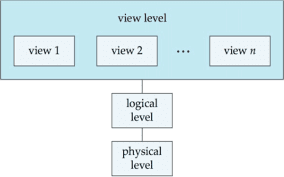Three Levels of Data Abstraction:
We know that a database system is a collection of interrelated files and a set of programs that allow users to access and modify these files.
A major purpose of a database system is to provide users with an abstract view of the data. The system hides certain details of how the data are stored and maintained within the database system.
In order to be usable, the system must retrieve data efficiently. This need for the efficiency has lead designers to use complex data structures to represent data in the database.
Many database system users are not computer trained. As such the developers hide the complexity from users through several levels of abstraction. This is done to simplify users’ interactions with the system.
There are three levels of abstraction provided by the DBMS:
1.
Physical level:
- It is the lowest level of abstraction.
- It describes how the data are actually stored.
- The physical level describes complex low level data structures in detail.
2.
Logical level:
- It is the next higher level of abstraction.
- It describes what types of data are stored in the database and what relationships exist among those data.
- The logical level describes the entire database in terms of a small number of relatively simple structures.
- The user of the logical level does not need to be aware of complexity associated at the physical level structures.
- DBA have to decide what information to keep in the database uses the logical level of abstraction.
3.
View level:
- This is the highest level of abstraction.
- It describes only part of the entire database.
- Even though the logical level uses simpler structures, the complexity still exists because of the variety of information that is stored in a large database.
- However, many users of the database system do not need all this information; instead they need to access only a part of the database.
- As such, this view level of abstraction exists to simplify their interaction with the system.
- It should be noted that the system may provide many views for the same database as per the user requirements.

No comments:
Post a Comment